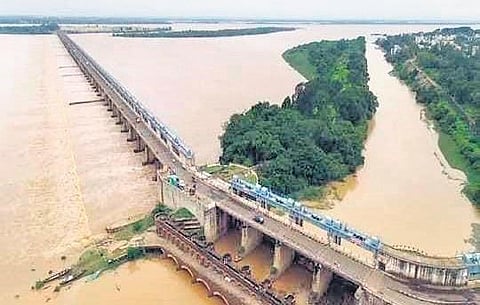

RAJAMAHENDRAVARAM: Even as five districts are bracing to face flood fury with Sir Arthur Cotton Barrage near here rapidly filling up, an irrigation expert and former superintendent engineer of Polavaram project said the situation would not be as alarming this time as it was in the same period of 1953 and 1986.
However, the expert offered a disclaimer saying no engineer could predict the nature's fury. "July is the beginning of the rainy season, the discharge through the barrage and the rains in the catchment area should be considered while assessing the inflows into the River Godavari. I strongly believe that the flood situation of 1953 and 1986 will not repeat this July," K Haranath said.
The technocrat added that the August rains in the upper Godavari catchment area would be more severe than July. He hastened to add that the river banks should be strengthened, and constructions along the waterbody should be checked avoid a calamity.
Godavari that overflowed in 1953 and 1986 had wreaked havoc in the region. Around 30,03,100 cusecs of water was discharged into the Bay of Bengal in 1953, while nearly 36 lakh cusecs of water was emptied into the sea in 1986, he pointed out while terming 1953 and 1986 "the sad years in the history of the River Godavari".
The 1953 floods breached Kotilingala Revu (ghat) in Rajamahendravaram and the biggest timber yard in south India was washed away. It also caused great loss to life and property. In 1986, the Dowleswaram barrage was washed away and the floodwaters inundated several areas in Polavaram and Konaseema, he recalled.
Haranath felt the discharge through Sir Arthur Cotton Barrage would be around 25 lakh this month. The current flood situation is the eighth highest recorded in the past 75 years. The river has a capacity to hold inflows up to 30 lakh cusecs.
"Previous governments had strengthened the Godavari bunds and flood banks extending to 535 km in the erstwhile Godavari districts. Now it is high time that we strengthened the river banks. In several places, people have dug the banks. Sand miners, too, have dug up the banks. It has weakened the banks. These banks can be breached with 20 lakh cusecs of water. We should give top priority to strengthening the banks. Otherwise we have to see the fury of Godavari matha," he said.
Haranath lamented the rapid urbanisation of the river banks. "It's not good. How can permit constructions on river banks? Villages have been developed along the river, at the cost of flood banks. Enough is enough. Do not any construction along the banks. The entire land along the river Godavari should be under the control of the irrigation department," he opined.